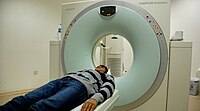
Photo from wikipedia
Introduction The improvement of low-dose CT (LDCT) lung cancer screening selection criteria could help to include more individuals who have lung cancer, or in whom lung cancer will develop, while… Click to show full abstract
Introduction The improvement of low-dose CT (LDCT) lung cancer screening selection criteria could help to include more individuals who have lung cancer, or in whom lung cancer will develop, while avoiding significant cost increase. We evaluated baseline results of LDCT lung cancer screening in a population with a heterogeneous risk profile for lung cancer. Methods LDCT lung cancer screening was implemented alongside a preventive health programme in a private hospital in Brazil. Individuals older than 45 years, smokers and former smokers, regardless of tobacco exposure, were included. Patients were classified according to the National Lung Screening Trial (NLST) eligibility criteria and to PLCOm2012 6-year lung cancer risk. Patient characteristics, CT positivity rate, detection rate of lung cancer and false-positive rate were assessed. Results LDCT scans of 472 patients were evaluated and three lung adenocarcinomas were diagnosed. CT positivity rate (Lung-RADS 3/4) was significantly higher (p=0.019) in the NLST group (10.1% (95% CI, 5.9% to 16.9%)) than in the non-NLST group (3.6% (95% CI, 2.62% to 4.83%)) and in the PLCOm2012 high-risk group (14.3% (95% CI, 6.8% to 27.7%)) than in the PLCOm2012 low-risk group (3.7% (95% CI, 2.9% to 4.8%)) (p=0.016). Detection rate of lung cancer was also significantly higher (p=0.018) among PLCOm2012 high-risk patients (5.7% (95% CI, 2.5% to 12.6%)) than in the PLCOm2012 low-risk individuals (0.2% (95% CI, 0.1% to 1.1%)). The false-positive rate for NLST criteria (16.4% (95% CI, 13.2% to 20.1%)) was higher (p<0.001) than for PLCOm2012 criteria (7.6 (95% CI, 5.3% to 10.5%)). Discussion Our study indicates a lower performance when screening low-risk individuals in comparison to screening patients meeting NLST criteria and PLCOm2012 high-risk patients. Also, incorporating PLCOm2012 6-year lung cancer risk ≥0.0151 as an eligibility criterion seems to increase lung cancer screening effectiveness.
Journal Title: BMJ Open Respiratory Research
Year Published: 2020
Link to full text (if available)
Share on Social Media: Sign Up to like & get
recommendations!